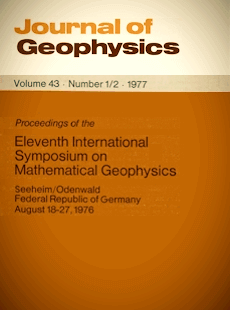The upper mantle under Western Europe inferred from the dispersion of Rayleigh modes
Article Sidebar

Vols. 1-18 (1924-1944), ISSN 0044-2801
Main Article Content
Abstract
A stacking technique is applied to measure phase velocities of the fundamental and several higher Rayleigh modes over an array of long period stations located in Western Europe. The higher mode dispersion has been measured for periods between 25 and 100 s and for phase velocities up to 7.5 km/s. Using Backus-Gilbert inversion, a detailed model for the shear wave velocity in the upper mantle under the array is obtained. The low velocity zone is located between 150 and 230 km depth and is not very pronounced, but it is preceded by a rise in S velocity around 120 km depth. Strong velocity gradients are found at depths of 360 and 520 km. A good fit to the data can only be obtained if a zone of low density is assumed at a depth of 220 km or there about. As yet little can be said about depth, shape and extent of this zone, but the magnitude of the density drop implies a chemical or mineralogical stratification. A mechanism based on eclogite fractionation (Press, 1969) appears to be a likely candidate as the cause for such a gravitationally unstable stratification.
 ARK: https://n2t.net/ark:/88439/y010885
ARK: https://n2t.net/ark:/88439/y010885
Permalink: https://geophysicsjournal.com/article/161
Article Details
References
Anderson, D.L., Hart, R.S. (1976) An Earth model based on free oscillations and body waves. J. Geophys. Res. 81:1461
Backus, G., Gilbert, F. (1970) Uniqueness in the inversion of inaccurate gross Earth data. Phil. Trans. Roy. Soc. London Ser. A266:123
Bath, M. (1976) Average crustal structure of Sweden. Pure Appl. Geophys. 88, 75, 1971 Cara, M.: Observations d'ondes Sa de type SH. Pure Appl. Geophys. 114:141
Clark, S.P., Ringwood, A.E. (1964) Density distribution and constitution of the mantle. Rev. Geophys. 2:35
Crampin, S. (1964) Higher modes of seismic surface waves: Phase velocities across Scandinavia. J. Geophys. Res. 69:4801
Crampin, S. (1967) Coupled Rayleigh-Love second modes. Geophys. J. 12:229
Der, Z.A., Landisman, M. (1972) Theory for errors, resolution and separation of unknown variables in invers problems, with applications to the mantle and crust of Southern Africa and Scandinavia.
Geophys. J. 27:137
Dziewonski, A.M., Hales, A.L. (1972) Numerical analysis of dispersed seismic waves. Methods in Computational Physics 11:39
Elzasser, W.M. (1971) Sea floor spreading as thermal convection. J. Geophys. Res. 76:1101
Fagerness, V., Kanestrom, R. (1973) Variations in upper mantle structure as derived from Pn and Sn waves. Pure and Appl. Geophys. 109:1762
Forsyth, D.W. (1975) A new method for the analysis of multi-mode surface wave dispersion: Application to Love wave propagation in the East Pacific. Bull. Seism. Soc. Am. 65:323
Gilbert, F. (1971) Ranking and winnowing gross Earth data for inversion and resolution. Geophys. J. 23:125
Gilbert, F., Dziewonski, A.M. (1975) An application of normal mode theory to the retrieval of structural parameters and source mechanisms from seismic spectra. Phil. Trans. Roy Soc. London 278:187
Green, D.H., Ringwood, A.E. (1970) Mineralogy of peridotite compositions under upper mantle conditions. Phys. Earth Planet. Interiors 3:359
Hirn, A., Steinmetz, L., Kind, R., Fuchs, K. (1973) Long range profiles in W. Europe: IL Fine structure of the lower lithosphere in France (Southern Bretagne). Z. Geophys. 39:363
Hsi-Ping Liu, Anderson, D.L., Kanamori, H. (1976) Velocity dispersion due to anelasticity; implications for seismology and mantle composition. Geophys. J. (In press)
Ito, K., Kennedy, G.C. (1971) An experimental study of the basalt-garnet granulite-eclogite transition. In: Heacock, J.G. (Ed.) The structure and physical properties of the Earth's crust, Geophys. Monogr. Ser. 14, Washington
Jackson, D.D. (1972) Interpretation of inaccurate, insufficient and inconsistent data. Geophys. J. 28:97
Jacoby, W.R. (1970) Instability in the Upper Mantle and global plate movements. J. Geophys. Res. 75:5671
Knopoff, L. (1972) Observation and inversion of surface wave dispersion. Tectonophysics 13:497
Kovach, R.L. (1965) Seismic surface waves: Some observations and recent developments. Phys. Chem. Earth 6:251
Lehmann, I. (1961) Sand the structure of the upper mantle. Geophys. J. 4:124
Mayer-Rosa, D., Mueller, St. (1973) The gross velocity depth distribution of P and S waves in the upper mantle of Europe from earthquake observations. Z. Geophys. 39:395
Mendiguren, J.A. (1973) Identification of free oscillation spectral peaks for 1970 July 31, Colombian deep shock using the excitation criterion. Geophys. J. 33:281
Nolet, G. (1975) Higher Rayleigh modes in Western Europe. Geophys. Res. Letters 2:60
Nolet, G. (1976) Higher modes and the determination of upper mantle structure. Ph.D. thesis, Utrecht
Nolet, G., Panza, G.F. (1976) Array analysis of seismic surface waves: Limits and possibilities. Pure Appl. Geophys. 114:775
Payo, G. (1964) Crustal phases across the Iberian Peninsula region. Ann. di Geophys. 17:523
Payo, G. (1964) Iberian peninsula crustal structure from surface wave dispersion. Bull. Seism. Soc. Am. 55:727
Press, F. (1968) Earth models obtained by Monte Carlo inversion. J. Geophys. Res. 73:5223
Press, F. (1969) The suboceanic mantle. Science 165:174
Press, F. (1970) Earth models consistent with geophysical data: Phys. Earth Planet. Interiors 3:3
Press, F. (1972) The Earth's interior as inferred from a family of models. In: Robertson, E.C. (Ed.) The nature of the solid Earth. McGraw-Hill, New York
Randall, M.J. (1976) Attenuative dispersion and frequency shift of the Earth's free oscillations. Phys. Earth Planet. Interiors 12:P1
Sapin, M., Prodehl, C. (1973) Long Range profiles in Western Europe I-crustal structure between Bretagne and the central Massif of France. Ann. Geophys. 29:127
Schubert, G., Turcotte, D.L. (1972) One-dimensional model of shallow-mantle convection. J. Geophys. Res. 77:945
Seidl, D. (1971) Spezielle Probleme der Ausbreitung Seismischer Obenflachenwellen mit Beobachtungsbeispielen aus Europa. Thesis, Karlsruhe
Steinmetz, L., Hirn, A., Perrier, G. (1974) Reflexions seismiques a la base de l'asthenosph6re. Ann. Geophys. 30:173
Vlaar, N.J. (1975) The driving mechanism of plate tectonics: a qualitative approach. In: Borradaile, G.J. et al. (Eds.) Progress in geodynamics, Amsterdam
Vlaar, N.J., Wortel, R. (1976) Lithospheric aging, instability and subduction. Tectonophysics 32:331
Wiggins, R.A. (1972) The general linear inverse problem: implication of surface waves and free oscillations for Earth structure Rev. Geophys. Space Phys. 10:251











